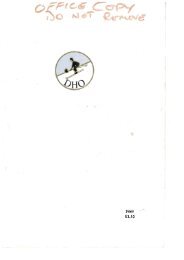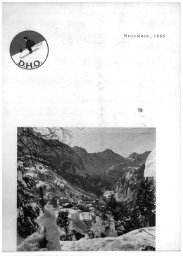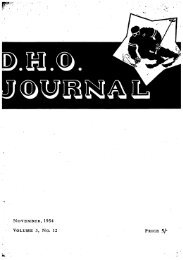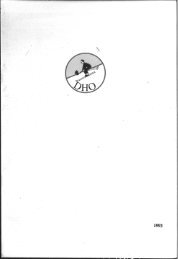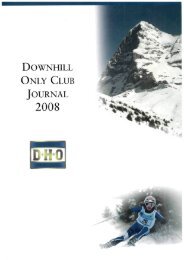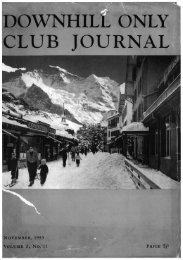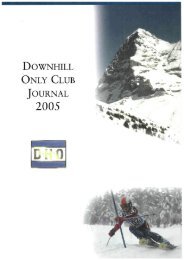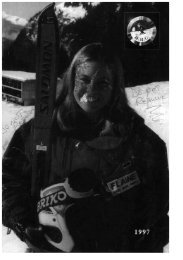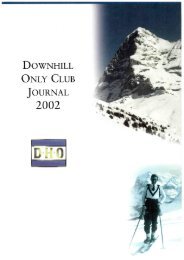' ' • NOVEMBER, 1 969 - the DHO
' ' • NOVEMBER, 1 969 - the DHO
' ' • NOVEMBER, 1 969 - the DHO
You also want an ePaper? Increase the reach of your titles
YUMPU automatically turns print PDFs into web optimized ePapers that Google loves.
THE WAB<br />
The<br />
HE newcomer's first glimpse of Wengen comes<br />
Tinevitably from <strong>the</strong> windows of a WAB train,<br />
unless he chooses to walk up from Lauterbrunnen,<br />
which few care to do <strong>the</strong>se days. Yet less than<br />
eighty years ago, <strong>the</strong> long climb was <strong>the</strong> only way to<br />
get to Wengen and beyond. Not surprisingly, few<br />
people wanted to make <strong>the</strong> journey.<br />
Tourism in <strong>the</strong> high alps is a relatively modern<br />
pastime. Even so, <strong>the</strong> Lauterbrunnen valley seems<br />
to have been popular even in <strong>the</strong> middle ages.<br />
There are records going back to <strong>the</strong> 12th century of<br />
religious and secular notables visiting both Lauterbrunnen<br />
and Grindelwald to attend <strong>the</strong> dedication<br />
of churches. One wonders if it was <strong>the</strong> churches<br />
which drew <strong>the</strong> dignitaries or if <strong>the</strong> dignitaries<br />
arranged for <strong>the</strong> churches to be built so that <strong>the</strong>y<br />
could have <strong>the</strong> excuse for a trip to <strong>the</strong> mountains.<br />
Never<strong>the</strong>less, <strong>the</strong> 16th and 17th centuries saw<br />
people come along to study <strong>the</strong> mountains, but, one<br />
ga<strong>the</strong>rs, at a distance, However, by <strong>the</strong> 18th century,<br />
guides began to make an appearance, student trips<br />
were organized and it became fashionable to attend<br />
<strong>the</strong> 'Gletscherschule'. The tracks across <strong>the</strong> mountains<br />
were, still very poor, and, in fact, <strong>the</strong>re<br />
is no written record of <strong>the</strong> crossing from Lauterbrunnen<br />
to Grindelwald before 1776.<br />
In <strong>the</strong> 19th century, foreigners began to be seen<br />
more and more in <strong>the</strong> valleys. Some of <strong>the</strong>m would<br />
spend months on end in Interlaken, and at popular<br />
times, accommodation in Interlaken became hard<br />
to find. People had to be put up in places like<br />
Bonigen and Lauterbrunnen, and this meant <strong>the</strong><br />
development of a thriving local transport industry.<br />
It is hardly surprising that a plan was first brought<br />
out about 1870 to build a railway of sorts up to<br />
Wengernalp. The idea was to build a conventional<br />
railway to Lauterbrunnen and Grindelwald, and<br />
from those places, a combination of waterpowered<br />
funiculars and steam-powered cog railways would<br />
climb over <strong>the</strong> Scheidegg. The idea was dropped,<br />
though, because of its high cost.<br />
Some twenty years later, however, <strong>the</strong> BOB was<br />
to open up <strong>the</strong> valleys to Grindelwald and Lauterbrunnen,<br />
and <strong>the</strong> old idea of <strong>the</strong> mountain railway<br />
came under close scrutiny again.<br />
Now, people do not change much. There were<br />
loud and numerous protests about <strong>the</strong> invasion of<br />
<strong>the</strong> mountains. The protests came not only from <strong>the</strong><br />
local inhabitants, but from mountain and nature<br />
lovers all over <strong>the</strong> world. The local people, however,<br />
were more specific in <strong>the</strong>ir opposition—and in <strong>the</strong><br />
fears which led to <strong>the</strong>m. The 'ring of iron' would<br />
bring too much change; it would disturb a tranquil<br />
life. They preferred life to be quiet and predictable.<br />
Tourism was not yet a real industry in <strong>the</strong> valleys—<br />
in 1889, <strong>the</strong>re were only two hotels in Lauterbrunnen,<br />
and four in Wengen. The Mayor of<br />
Interlaken protested that <strong>the</strong> plan was premature—<br />
nature would be disturbed. Not surprisingly, <strong>the</strong><br />
organizers of <strong>the</strong> local transport facilities were, to a<br />
man, against <strong>the</strong> plan, and <strong>the</strong>y sought to claim<br />
compensation if <strong>the</strong> railways did go up into <strong>the</strong><br />
mountains.<br />
The outcome was <strong>the</strong> usual series of promises<br />
people get from <strong>the</strong> authorities, and which <strong>the</strong><br />
authorities have no intention of keeping. The<br />
Oberlander Zeitung put <strong>the</strong> matter into a nutshell.<br />
'First of all, <strong>the</strong>y wanted to get <strong>the</strong> communities to<br />
contribute to a railway between <strong>the</strong> lakes—<strong>the</strong><br />
Brunigbahn. The communities said: Yes, as long<br />
as no railways are built into <strong>the</strong> Valleys! And<br />
<strong>the</strong>y were given promises about that. Then came <strong>the</strong><br />
valley railways, at least in concept, and <strong>the</strong> people of<br />
Lauterbrunnen said: Yes, as long as you don't build<br />
a railway to Miirren. Then came <strong>the</strong> plan to build a<br />
railway to Murren, and <strong>the</strong> Milrreners said: Yes, as<br />
long as you don't later want to build one up to <strong>the</strong><br />
Schilthorn. And <strong>the</strong>y got that promise too.' Well,<br />
<strong>the</strong> promise about <strong>the</strong> Schilthombahn at least seems<br />
to have lasted longer than <strong>the</strong> rest!<br />
Photo Wengernalpbahn<br />
Steamtrain at Wengernalp Station<br />
about 1900.<br />
Page Forty-five




